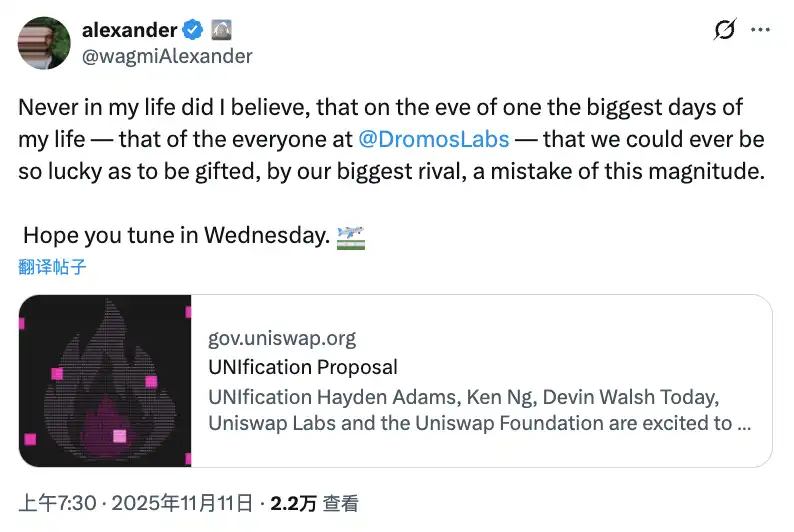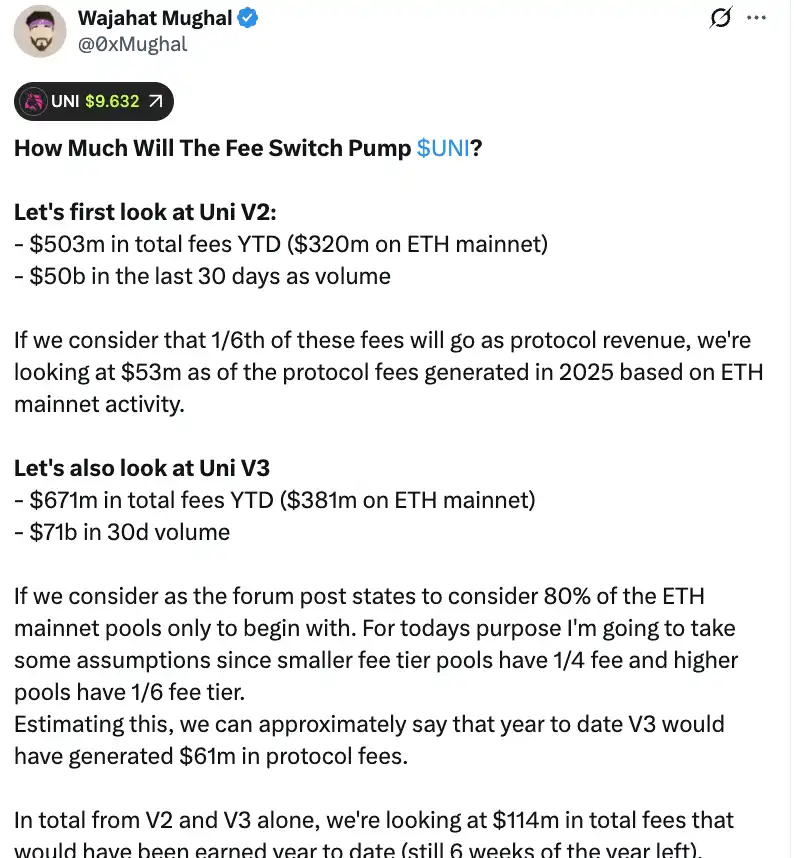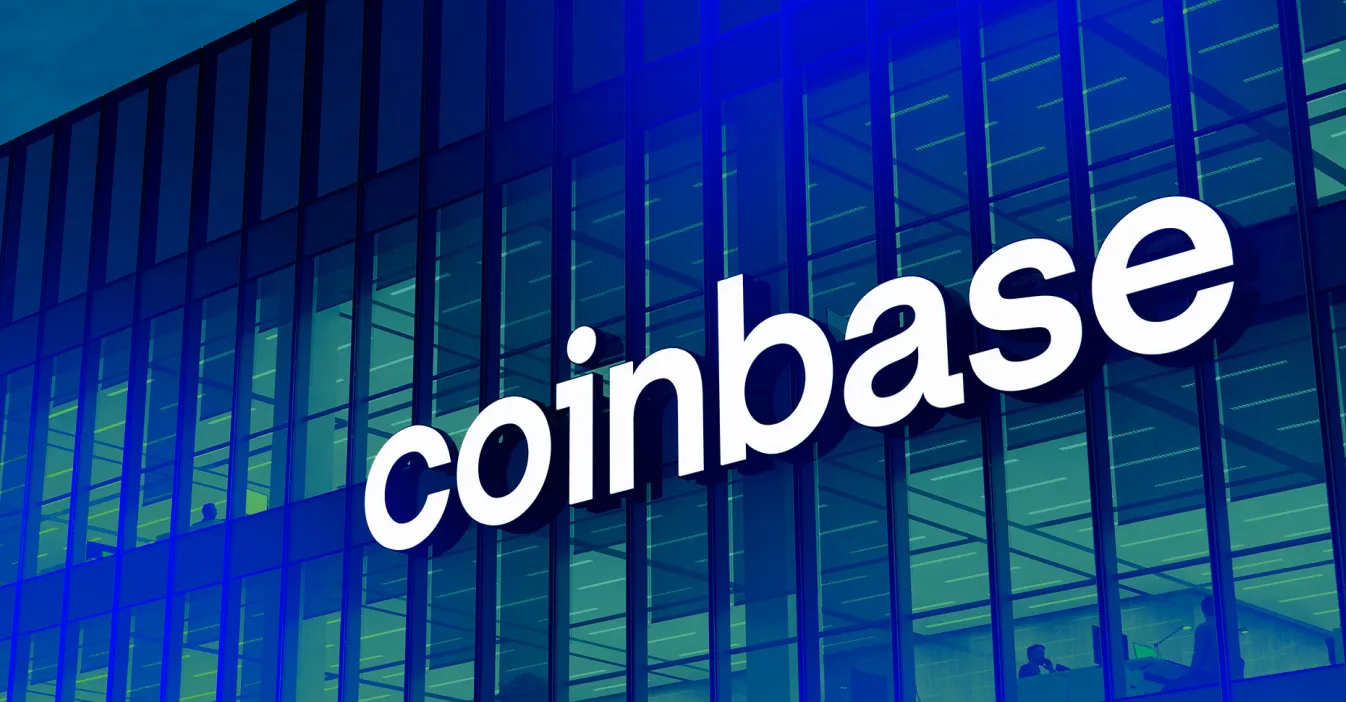Waking up, UNI has surged nearly 40%, bringing the entire DeFi sector along for the ride.
The reason for the rise is that Uniswap has revealed its final trump card. Uniswap founder Hayden has released a new proposal, the core content of which revolves around the often-discussed "fee switch" topic. In fact, this proposal has been brought up 7 times over the past two years, and it is no longer a new topic for the Uniswap community.

However, this time is different; the proposal is initiated by Hayden himself, and in addition to the fee switch, it also includes a series of measures such as token burning, and the merger of Labs and Foundation. Some major players have already expressed their support, and in the prediction market, the probability of the proposal passing is as high as 79%.
2 Years of 7 Failures: The "Fee Switch" Struggle
The fee switch is actually a fairly common mechanism in the DeFi space. Take Aave as an example; it successfully activated the fee switch in 2025, using a "buy + distribute" model to repurchase AAVE tokens with protocol revenue, pushing the token price from $180 to $231, achieving an annualized increase of 75%.
In addition to Aave, protocols like Ethena, Raydium, Curve, and Usual have also seen significant success with their fee switches, providing sustainable token economics examples for the entire DeFi industry.
Given that there are so many successful precedents, why has Uniswap struggled to pass it?
a16z Has Relented, But Uniswap's Troubles Are Just Beginning
Here, we must mention a key player— a16z.
In Uniswap's history, the quorum has generally been low, usually requiring around 40 million UNI to meet the voting threshold. However, this venture capital giant previously controlled about 55 million UNI tokens, which had a very direct impact on the voting results.
They have always been opponents of related proposals.
In the two temperature checks in July 2022, they chose to abstain, only expressing some concerns in the forum. But by the third proposal in December 2022, when pools like ETH-USDT and DAI-ETH were preparing to activate a 1/10 fee rate on-chain vote, a16z cast a clear opposing vote, utilizing 15 million UNI's voting power. This vote ultimately ended with a 45% support rate; although supporters were in the majority, it failed due to insufficient quorum. In the forum, a16z clearly stated: "We ultimately cannot support any proposal that does not consider legal and tax implications." This was their first public opposition.
In subsequent proposals, a16z maintained this stance. In May and June 2023, GFX Labs launched two fee-related proposals in succession. Although the June proposal received a 54% support rate, it ultimately failed again due to insufficient quorum, influenced by a16z's 15 million opposing votes. By the governance upgrade proposal in March 2024, the same script played out again—about 55 million UNI supported, but it failed due to a16z's opposition. The most dramatic instance was from May to August 2024, when the proposal attempted to mitigate legal risks by establishing a Wyoming DUNA entity. The vote was originally scheduled for August 18 but was indefinitely postponed due to "new issues from unnamed stakeholders," widely believed to be a16z.
So what exactly is a16z worried about? The core issue lies in legal risks.
They believe that once the fee switch is activated, UNI tokens may be classified as securities. According to the famous Howey test standard in the U.S., if investors have a reasonable expectation of "profits from the efforts of others," then the asset may be deemed a security. The fee switch creates such an expectation—protocols generate income, and token holders share in the profits, which is highly similar to the profit distribution model of traditional securities. a16z partner Miles Jennings bluntly stated in a forum comment: "A DAO without a legal entity faces personal liability exposure."
In addition to securities law risks, tax issues are also tricky. Once fees flow into the protocol, the IRS may require the DAO to pay corporate taxes, with preliminary estimates of back taxes potentially reaching $10 million. The problem is that a DAO itself is a decentralized organization without the legal entity and financial structure of a traditional business, making it unclear how to pay taxes and who would bear the costs, leaving these questions unresolved. In the absence of clear solutions, hastily activating the fee switch could expose all token holders participating in governance to tax risks.
As of now, UNI remains the largest single token holding in a16z's cryptocurrency portfolio, holding about 64 million UNI, still capable of independently influencing voting results.
But we all know that with Trump's election as president and the SEC's turnover, the crypto industry has welcomed a political spring of stability, and Uniswap's legal risks have diminished, indicating a gradual softening of a16z's stance. Clearly, this is no longer an issue, and the likelihood of this proposal passing has significantly increased.
However, this does not mean that there are no other conflicts; Uniswap's fee switch mechanism still has some points of contention.
You Can't Have Your Cake and Eat It Too
To understand these new points of contention, we first need to briefly discuss how the fee switch specifically operates.
From a technical implementation perspective, this proposal makes detailed adjustments to the fee structure. In the V2 protocol, the total fee remains at 0.3%, but 0.25% will be allocated to LPs, and 0.05% will belong to the protocol. The V3 protocol is even more flexible, with protocol fees set at one-fourth to one-sixth of LP fees. For example, in a 0.01% liquidity pool, the protocol fee is 0.0025%, equivalent to a 25% share; while in a 0.3% pool, the protocol fee is 0.05%, accounting for about 17%.
Based on this fee structure, Uniswap conservatively estimates it could generate annual revenue of $10 million to $40 million, and in a bull market scenario, based on historical peak trading volumes, this figure could reach $50 million to $120 million. Meanwhile, the proposal also includes an immediate burn of 100 million UNI tokens, equivalent to 16% of the circulating supply, and establishes a continuous burning mechanism.
In other words, through the fee switch, UNI will transform from a "worthless governance token" into a real revenue-generating asset.
This is certainly great news for UNI holders, but the problem lies precisely here. Because the essence of the "fee switch" is the redistribution of revenue between LPs and the protocol.
The total fees paid by traders will not change; it is just that a portion of the revenue, which was originally entirely owned by LPs, will now be allocated to the protocol. The costs are borne by the LPs; as protocol revenue increases, LP income will inevitably decrease.
You can't have your cake and eat it too. In the question of "Do we want LPs or protocol revenue?" Uniswap has clearly chosen the latter.

Community discussions suggest that once the "fee switch" is activated, half of Uniswap's trading volume on the Base chain could disappear overnight.
The potential negative impact of this redistribution should not be underestimated. In the short term, LP earnings could be reduced by 10% to 25%, depending on the protocol fee sharing ratio. More seriously, model predictions suggest that 4% to 15% of liquidity could migrate from Uniswap to competing platforms.
To mitigate these negative impacts, the proposal also includes some innovative compensation measures. For example, the PFDA mechanism for MEV internalization can provide additional income for LPs, with each $10,000 trade potentially yielding an extra $0.06 to $0.26. The V4 version's Hooks feature supports dynamic fee adjustments, and aggregator hooks can open up new revenue sources. Additionally, the proposal adopts a phased implementation strategy, starting with core liquidity pools for pilot testing, monitoring impacts in real-time, and adjusting based on data.
The Dilemma of the Fee Switch
Despite these mitigation measures, whether they can truly alleviate LPs' concerns and allow this proposal to ultimately be implemented will likely require time to verify. After all, even with Hayden personally involved, it may not necessarily save Uniswap from its predicament on this issue.
Because the more direct threat comes from market competition, especially in the face-off with Aerodrome on the Base chain.

After Uniswap's proposal, Aerodrome's development team CEO Alexander sarcastically remarked on X: "I never thought that on the eve of Dromos Labs' most important day, our biggest competitor would deliver such a significant blunder."
Aerodrome is Crushing Uniswap on the Base Chain
Data shows that in the past 30 days, Aerodrome's trading volume was approximately $20.465 billion, capturing 56% of the market share on the Base chain; while Uniswap's trading volume on Base was about $12-15 billion, with a market share of only 40-44%. Aerodrome not only leads in trading volume by 35-40%, but also surpasses Uniswap in TVL with $473 million compared to Uniswap's $300-400 million.
The root of the gap lies in the significant difference in LP yields. Taking the ETH-USDC pool as an example, Uniswap V3's annualized yield is about 12-15%, solely from trading fees; while Aerodrome, through AERO token incentives, can offer annualized yields of 50-100% or even higher, which is 3-7 times that of Uniswap. In the past 30 days, Aerodrome distributed $12.35 million in AERO incentives, precisely guiding liquidity through the veAERO voting mechanism. In contrast, Uniswap mainly relies on organic fees, occasionally launching targeted incentive programs, but the scale is far less than that of its competitors.
As someone in the community pointed out: "The reason Aerodrome can crush Uniswap in trading volume on Base is that liquidity providers only care about the return on every dollar of liquidity invested. Aerodrome excels in this regard." This observation is spot on.
For LPs, they won't stay because of Uniswap's brand influence; they only look at yields. In emerging L2s like Base, Aerodrome, as a native DEX, has established a strong first-mover advantage with its specially optimized ve(3,3) model and high token incentives.
In this context, if Uniswap activates the fee switch and further reduces LP earnings, it may accelerate the migration of liquidity to Aerodrome. Model predictions suggest that the fee switch could lead to a 4-15% loss of liquidity, and in a competitive battlefield like Base, this percentage could be even higher. Once liquidity decreases, trading slippage increases, and trading volume will also decline, creating a negative spiral.
Can the New Proposal Save Uniswap?
From a purely numerical perspective, the fee switch can indeed bring considerable revenue to Uniswap. According to detailed calculations by community member Wajahat Mughal, the situation is already quite promising when looking at just the V2 and V3 versions.

The V2 protocol has generated a total fee of $503 million from the beginning of 2025 to now, with the Ethereum mainnet contributing $320 million, and the trading volume in the last 30 days reaching $50 billion. If calculated based on a 1/6 fee sharing, the protocol fee revenue from Ethereum mainnet activity in 2025 is expected to reach $53 million. The V3 protocol has performed even stronger, with total fees reaching $671 million from the beginning of the year, of which the Ethereum mainnet accounts for $381 million, and the 30-day trading volume has reached $71 billion. Considering the different sharing ratios of fee pools—low-fee pools charge 1/4 of the protocol fees, while high-fee pools charge 1/6—V3 may have already generated $61 million in protocol fees from the beginning of the year to now.
Adding V2 and V3 together, the protocol fee revenue from the beginning of the year is expected to have reached $114 million, and this is with 6 weeks still remaining in the year. More critically, this figure has not yet touched Uniswap's full revenue potential. This calculation does not account for the remaining 20% of V3 pools, fees from all chains outside the Ethereum mainnet (especially Base, which generates fees almost equivalent to the Ethereum mainnet), V4 trading volume, protocol fee discount auctions, UniswapX, aggregator hooks, and the sorting revenue from Unichain. If all of these are taken into account, the annualized revenue could easily exceed $130 million.
Combined with the plan to immediately burn 100 million UNI tokens (valued at over $800 million at current prices), Uniswap's token economics will undergo a fundamental change. The fully diluted valuation after the burn will drop to $7.4 billion, with a market cap of about $5.3 billion. Based on an annualized revenue of $130 million, Uniswap could repurchase and burn about 2.5% of the circulating supply each year.
This means that UNI's price-to-earnings ratio is about 40 times. While this may not seem cheap, considering that many revenue growth mechanisms have yet to be fully unleashed, there is significant room for this number to decline. As someone in the community lamented: "This is the first time the UNI token truly appears to have holding appeal."
However, behind these impressive numbers lie significant concerns that cannot be ignored. First, the trading volume in 2025 is significantly higher than in previous years, largely due to the bull market. Once the market enters a bear cycle, trading volume will drop sharply, and protocol fee revenue will shrink accordingly. Using revenue forecasts based on bull market data as a basis for long-term valuation is clearly somewhat misleading.
Second, the specific operational method of the repurchase mechanism remains unknown. Will it use an automated repurchase system similar to Hyperliquid, or will it be executed in other ways? The frequency of repurchases, price sensitivity, and market impact—these details will directly affect the actual effectiveness of the burn mechanism. If not executed properly, large-scale market repurchases could instead trigger price volatility, putting UNI holders in an awkward position of "robbing Peter to pay Paul."
As platforms like Aerodrome, Curve, Fluid, and Hyperliquid are attracting liquidity through high incentives, will Uniswap's approach of cutting LP earnings accelerate capital outflow? The data looks good, but if liquidity—the foundation—is lost, even the most beautiful revenue forecasts are just castles in the air.
The fee switch can undoubtedly provide value support for UNI. But whether it can truly "save" Uniswap and bring this former DeFi giant back to its peak will likely require both time and market validation.
免责声明:本文章仅代表作者个人观点,不代表本平台的立场和观点。本文章仅供信息分享,不构成对任何人的任何投资建议。用户与作者之间的任何争议,与本平台无关。如网页中刊载的文章或图片涉及侵权,请提供相关的权利证明和身份证明发送邮件到support@aicoin.com,本平台相关工作人员将会进行核查。




